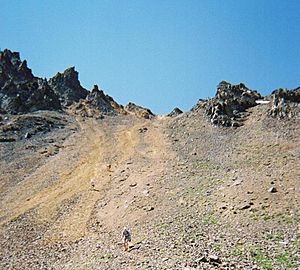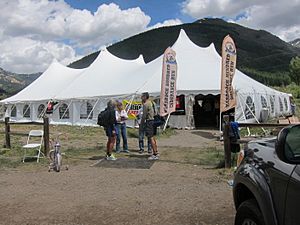Hardrock Hundred Mile Endurance Run facts for kids
Quick facts for kids Hardrock Hundred Mile Endurance Run |
|
|---|---|

Photo taken during 2006 race. Grant Swamp Pass, 12,900 ft (3,900 m)
|
|
| Date | July |
| Location | Silverton, Colorado |
| Event type | Ultramarathon trail run |
| Distance | 102.5-mile (165.0 km) |
| Established | 1992 |
| Course records | Men: François D'Haene 21:45:50 (2021, counter-clockwise) Ludovic Pommeret 21:33:06 (2024, clockwise) Women: Katie Schide 25:50:23 (2025, counter-clockwise) Courtney Dauwalter 26:11:49 (2024, clockwise) |
| Official site | https://www.hardrock100.com/ |
The Hardrock Hundred Mile Endurance Run is an ultramarathon race that covers about 102.5 miles (165.0 km) (165 kilometers). It's known for its huge climbs, adding up to 33,000 feet (10,000 m) (10,000 meters) of elevation gain. The race takes place at a very high average elevation of over 11,000 feet (3,400 m) (3,350 meters). This challenging race follows a loop through old roads, dirt trails, and wild areas in the San Juan Mountains of Southern Colorado, USA. It honors the miners who settled in the area and built many of the trails used in the race.
Contents
What is the Hardrock 100?
The Hardrock 100 is a super tough running event. It starts and finishes in Silverton, Colorado. Along the way, runners pass through towns like Telluride and Ouray, and even a ghost town called Sherman. The course crosses thirteen big mountain passes, each between 12,000 and 13,000 feet high. Runners go above 12,000 feet (3,700 m) (3,650 meters) a total of 13 times! The highest point is the top of Handies Peak, which is 14,048 feet (4,282 meters) high.
Race Direction and Finish Line
The race has been held every July since 1992, except for a few times when there was too much snow, forest fires, trail damage, or a global pandemic. Each year, the race direction changes. One year it goes clockwise, and the next year it goes counter-clockwise. To finish the race, runners don't just cross a line. Instead, they must "kiss the Hardrock." This is a picture of a ram's head painted on a large rock from the old mining days.
How Long Does it Take?
Runners have 48 hours to complete the race. The fastest times recorded are by Ludovic Pommeret (21 hours, 33 minutes, 6 seconds) in 2024 and Courtney Dauwalter (26 hours, 11 minutes, 49 seconds) also in 2024. The average time to finish is over 41 hours. This is much longer than most 100-mile races.
Why is it So Hard?
The Hardrock 100 is extremely difficult for several reasons:
- High Elevations: The course is very high up, which can cause altitude sickness. This happens when your body doesn't get enough oxygen at high altitudes.
- Rugged Terrain: The trails are very rough. Runners face steep climbs and descents over loose rocks (called scree), snow, river crossings, and fields of large boulders.
- Night Running: The race starts at 6 AM. Many runners are out for so long that they see the sun set twice! They use flashlights or headlamps to navigate in the dark. Some parts of the trail are next to steep drop-offs, which can be scary at night.
- Weather Challenges: The weather in the San Juan Mountains can change very quickly. Nighttime temperatures can drop below freezing. Severe thunderstorms can appear suddenly, bringing rain, hail, strong winds, and lightning. Runners must be ready for all kinds of weather and carry extra clothing, food, and water.
Equipment and Training
Because of the extreme conditions, runners often use gear usually seen in hiking or mountain climbing. This includes trekking poles for balance and even crampons (spikes for shoes) if there's a lot of ice or snow. Many parts of the course are above the tree line, where no trees grow because it's too high and cold. It's common for participants to go two nights without sleep to finish the race.
The Rocky Mountain Slam
The Hardrock 100 is a key part of something called the "Rocky Mountain Slam." A runner completes this challenge if they finish the Hardrock race plus three other tough 100-mile races in the Rocky Mountains. These other races include the Leadville Trail 100, the Bear 100 Mile Endurance Run, the Bighorn 100, or the Wasatch Front 100 Mile Endurance Run. It's a huge achievement for any ultrarunner!
How the Race Started
In the early 1990s, a few ultrarunners named Gordon Hardman, John Cappis, and Charlie Thorn wanted to create a new 100-mile race. They wanted it to go through the San Juan Mountains, connecting towns like Lake City, Silverton, Telluride, and Ouray. A main idea was to use as many old mining trails as possible. They wanted the race to be a big physical and mental challenge, but also a way to celebrate the tough miners from the late 1800s and early 1900s. They imagined it as a "Post Graduate" run, meaning only experienced runners who had finished other 100-mile races could enter.
Knowing the Course
In the early years, knowing the route was super important. Runners received detailed maps and descriptions. There were, and still are, mandatory meetings to go over the course. Knowing the way could save a runner many hours. This led to "Camp Hardrock," where runners spend two weeks before the race hiking the course with the people who mark the trails. This helps them get to know the route. Over the years, the trail has become more established, making it a bit easier to follow.
How to Enter the Race
Each year, only 146 qualified runners are chosen to participate. They are selected in early December through a special lottery system by the race's Board of Directors. The winners from the previous year automatically get a spot. The lottery process has changed over time, as the race committee always tries to find the fairest way to choose runners.
To even enter the lottery, a runner must have finished one of about 30 very tough, mountainous 100-mile (or longer) ultramarathons in the past two years. If you finish the Hardrock 100, you're qualified for three years! A list of accepted races is available on the Hardrock 100 website.
Past Winners
| Edition | Date | Male Winner | Female Winner |
|---|---|---|---|
| 1 | 10–12 July 1992 | ||
| 2 | 9–11 July 1993 | ||
| 3 | 8–10 July 1994 | ||
| 4 | 7–9 July 1995 | Cancelled due to too much snow | |
| 5 | 12–14 July 1996 | ||
| 6 | 11–13 July 1997 | ||
| 7 | 10–12 July 1998 | ||
| 8 | 9–11 July 1999 | ||
| 9 | 7–9 July 2000 | ||
| 10 | 13–15 July 2001 | ||
| 11 | 12–14 July 2002 | Cancelled due to extreme wildfire danger | |
| 12 | 11–13 July 2003 | ||
| 13 | 9–11 July 2004 | ||
| 14 | 8–10 July 2005 | ||
| 15 | 14–16 July 2006 | ||
| 16 | 13–15 July 2007 | ||
| 17 | 12–14 July 2008 | ||
| 18 | 10–12 July 2009 | ||
| 19 | 9–11 July 2010 | ||
| 20 | 10–12 July 2011 | ||
| 21 | 13–15 July 2012 | ||
| 22 | 12–14 July 2013 | ||
| 23 | 11–13 July 2014 | ||
| 24 | 10–12 July 2015 | ||
| 25 | 15–17 July 2016 | ||
| 26 | 14–16 July 2017 | ||
| 27 | 20–21 July 2018 | ||
| 28 | 2019 | Cancelled due to weather | |
| 29 | 2020 | Cancelled due to COVID-19 | |
| 30 | 16–17 July 2021 | ||
| 31 | 15–16 July 2022 | ||
| 32 | 14–15 July 2023 | ||
| 33 | 12–14 July 2024 | ||
| 34 | 11–13 July 2025 | ||


